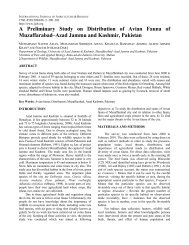Wildlife Diversity in the Punjab (Pakistan) - the Wildlife of Pakistan ...
Wildlife Diversity in the Punjab (Pakistan) - the Wildlife of Pakistan ...
Wildlife Diversity in the Punjab (Pakistan) - the Wildlife of Pakistan ...
You also want an ePaper? Increase the reach of your titles
YUMPU automatically turns print PDFs into web optimized ePapers that Google loves.
OnL<strong>in</strong>e Journal <strong>of</strong> Biological Sciences 1 (5): 417-420, 2001©Asian Network for Scientific Information 2001<strong>Wildlife</strong> <strong>Diversity</strong> <strong>in</strong> <strong>the</strong> <strong>Punjab</strong> (<strong>Pakistan</strong>)M. Anwar Maan and A. Aleem Chaudhry<strong>Punjab</strong> <strong>Wildlife</strong> Research Institute, Gatwala, Faisalabad, <strong>Pakistan</strong>Abstract: The results <strong>of</strong> <strong>the</strong> study <strong>in</strong>dicated that irrigated forest plantations are rich <strong>in</strong> wildlife diversity as comparedto sub-mounta<strong>in</strong>ous tract. Changa Manga <strong>Wildlife</strong> Sanctuary was highly diversified with 74 wildlife species. In Kundian(WS) 65 species were identified. In Cheechawatni (WS) and Lal Suhanra (NP) 60 and 58 species were observedrespectively. Only 35 species were observed <strong>in</strong> Shorkot (WS). In sub-mounta<strong>in</strong>ous tract, 38 species were observed <strong>in</strong>Kala Chitta Game Reserve, Attock and 33 <strong>in</strong> Kathar (GR). Variety <strong>of</strong> <strong>in</strong>sect species were also noted dur<strong>in</strong>g <strong>the</strong> study.Forestry operations, grass-cutt<strong>in</strong>g, kana stubb<strong>in</strong>g and livestock graz<strong>in</strong>g were major threats to wildlife. Forestryoperations with <strong>the</strong> objective <strong>of</strong> wildlife management will be helpful for <strong>the</strong> conservation <strong>of</strong> diversified fauna.Key words: Irrigated plantation, sub-mounta<strong>in</strong>ous tract, National Park, wild life sanctuary, game reserveIntroductionIrrigated forest plantations provide a potential habitat for avariety <strong>of</strong> wildlife species. These plantations have been raisedclear<strong>in</strong>g <strong>the</strong> thorn forest. Though relics <strong>of</strong> natural vegetationtypical <strong>of</strong> tropical thorn forest co-exit with irrigated plantation<strong>in</strong> <strong>the</strong> form <strong>of</strong> grooves and patches. However, SheeshamDalbergia sissoo, Kikar Acacia nilotica, Safeda Eucalyptus spp.and Popular Poplus spp are dom<strong>in</strong>ant plant species <strong>of</strong> irrigatedplantations. Mesquite Prosopis glandulosa has naturally<strong>in</strong>vaded <strong>in</strong> <strong>the</strong> plantations giv<strong>in</strong>g under-storey vegetation Transectscover. In some plantations mulberry Morus alba has beenplanted with sheesham. Shrubs, herbs and grasses provide <strong>the</strong>ground-cover, giv<strong>in</strong>g plantation a multi-storey cover. Thesedifferent canopy-strata attract a variety <strong>of</strong> wildllife speciesaccord<strong>in</strong>g to <strong>the</strong>ir preference for differetn plant species. Insub-mounta<strong>in</strong>ous tract, <strong>the</strong> habitat is scrub vegetation.Oleap hulai form ma<strong>in</strong> canopy cover, with various undergrowth.In both types <strong>of</strong> habitat i.e. irrigated forest plantations andsub-m ounta<strong>in</strong>ous tract, habitat degradation is a seriousproblem. Vegetation is exploited as trees are cut to be used astimber and lopped for firewood. Understorey shrubs, herbs andgrasses are heavily grazzed by livestock, destroy<strong>in</strong>g breed<strong>in</strong>gsites <strong>of</strong> ground nest<strong>in</strong>g birds and sub-terrestrial animal species.Such factors have adversely affected populations <strong>of</strong> wildlifespecies.For <strong>the</strong> protection <strong>of</strong> wildlife species, <strong>the</strong> plantations andpotential areas <strong>in</strong> sub-mounta<strong>in</strong>ous tract have been declaredwildlife sanctuaries (WS) and Game Reserves (GR) under<strong>Punjab</strong> <strong>Wildlife</strong> Act, 1974.Results and DiscussionIn <strong>Pakistan</strong> limited work has been carried by some authors, The results <strong>of</strong> <strong>the</strong> study are given <strong>in</strong> Table 1.regard<strong>in</strong>g identification <strong>of</strong> wildlife species. The work is ma<strong>in</strong>lyconf<strong>in</strong>ed to identification <strong>of</strong> avian species. Chaudhry an d A. Irrigated Forest Plantation: In Changa Manga plantationBhatti (1989) and Chaudhry et al. (1992), provided a list o f endangered mammalian species i.e., Nilgai Boselaphusavian species <strong>of</strong> Changa Manga <strong>Wildlife</strong> Sanctuary. Khan tragocamelus, Hog deer Axis porc<strong>in</strong>us and Spotted deer A.(1987), studied <strong>the</strong> bird-life <strong>of</strong> Daphar and Pakhowal Axis survive were observed. Few common peafowl PavoPlantation <strong>in</strong> district Gujrat. Chaudhry and Maan (1997) cristatus also survive under wild conditions. In plantation 14studied birds div ersity <strong>in</strong> Daphar <strong>Wildlife</strong> Sanctuary. Chaudhryet al. (1997), studied bird d iversity <strong>in</strong> Gatwala, Game Reserve,Faisalabad. However, overall diversity <strong>of</strong> plantations as awhole was not studied. So <strong>the</strong> present study was designedto determ<strong>in</strong>e <strong>the</strong> diversity <strong>of</strong> wildlife species <strong>in</strong> irrigated forestplantations and sub-mounta<strong>in</strong>ous tract <strong>in</strong> May-June, 1999.Mammals, birds, reptiles amphibians and <strong>in</strong>vertebrates<strong>in</strong>clud<strong>in</strong>g variety <strong>of</strong> <strong>in</strong>sect species were studied.Materials and Methods<strong>Diversity</strong> <strong>of</strong> wildlife species was studied by transect method<strong>in</strong> <strong>the</strong> follow<strong>in</strong>g areas.1. Changa Manga forest plantation (WS)2. Daphar and Pakhowal Forest Plantation (WS)3. Kundian Forest Plantation (WS)4. Lal Suhanra National Park (NP)5. Bhagat forest plantation (GR)6. Shorkot forest plantation (WS)7. Kamalia plantation (WS)8. Cheechawatni forest plantation (WS)9. Kathar, District Rawalp<strong>in</strong>di (GR)10. Potential areas for wildlife <strong>in</strong> District Attock i.e., KalaChitta, Mahora, Kheri Murat and Kali Dauli (GR)<strong>of</strong> variable length were studied, record<strong>in</strong>gobservations on both sides <strong>of</strong> <strong>the</strong> transect. <strong>Wildlife</strong> speciesobserved physically were noted. Indirect clues for <strong>the</strong>presence <strong>of</strong> species were also considered as:i Calls Partridges and song birdsii. Nests Vultures, kites and weaver birdsiii. Burrows Rates, mice, procup<strong>in</strong>eiv. Faecal pellets Hare, jackal, fox, jungle cat,nilgai, urial, ch<strong>in</strong>kara and hogdeerv. Marks on trees and Wild boar, porcup<strong>in</strong>egroundvi. Foot-pr<strong>in</strong>ts Hare, porcup<strong>in</strong>e, nilgai and deersFor behavioural study <strong>of</strong> wildlife species b<strong>in</strong>oculars (7x35)were used. For identification Ali and Riply (1987); Roberts(1991-92) were consulted. Habitat types and threats towildlife and habitat were identified.species <strong>of</strong> mammals, 50 birds, six reptiles, two amphibiansand 27 species <strong>of</strong> <strong>in</strong>sects were noted. With <strong>the</strong> help <strong>of</strong> burrowcharacteristics and faecal pellets, three ma<strong>in</strong> species <strong>of</strong>rodents viz., Indian mole rat Nesokia <strong>in</strong>dica, Indian gerbilTatera <strong>in</strong>dica and Field mouse Mus musculus were identified.Areas with Desmostachya and grasses were affected withNesokia <strong>in</strong>festation while o<strong>the</strong>r two species were common on<strong>the</strong> embankments <strong>of</strong> water courses and barren areas. Jackal,mongoose and Jungle cat were among predatory animals.Three hog deer were observed. Dropp<strong>in</strong>gs <strong>of</strong> Nilgai <strong>in</strong>dicatedthat small population <strong>of</strong> nilgai survive <strong>in</strong> <strong>the</strong> plantation. Withpro per management activities, population <strong>of</strong> both <strong>the</strong>endangered ungulate species can be restored. Among birdsonly residential and summer visitors were recorded.In Daphar plantation, hog deer were released for propagation417
Table 1: <strong>Diversity</strong> <strong>of</strong> wildlife speciesHabitatMaan and Chaudhry: <strong>Wildlife</strong> diversity <strong>in</strong> <strong>the</strong> <strong>Punjab</strong> (<strong>Pakistan</strong>)No. <strong>of</strong> wildlife species---------------------------------------------------------------------------------------------------------------------------------Mammals Birds Reptiles Amphibians InsectsChanga Manga (WS*) 14 50 6 2 27Attock (GR) 9 25 2 2 19Kundian (WS) 6 56 1 2 --Lal Suhanra (NP)*** 10 40 6 2 --Bhagat (GR) 6 30 2 2 19Shorkot (WS) 6 24 3 2 24Kamalia (WS) 7 40 1 2 27Cheechawatni (WS) 7 50 1 2 22Daphar (WS) 11 35 6 2 28Kathar (GR)** 4 24 3 2 13* WS=<strong>Wildlife</strong> Sanctuary ** GR= Game Reserve *** NP= National ParkNational Park, <strong>Wildlife</strong> Sanctuary and Game Reserve <strong>in</strong>dicate protective status <strong>of</strong> <strong>the</strong> area.that could not survive. Accord<strong>in</strong>g to watch and ward staff, shoot animals/birds at water po<strong>in</strong>ts.<strong>the</strong>r e was natural mortality <strong>in</strong> hog deer. Afterwards, due to Total 24 species <strong>of</strong> birds were noted along with variety <strong>of</strong>floods <strong>in</strong> <strong>the</strong> vic<strong>in</strong>ity <strong>of</strong> plantation, few hog deer <strong>in</strong>vaded <strong>the</strong> <strong>in</strong>sects. However, due to drought and low humidity, <strong>in</strong>sectplantation and presently four to five hog deer survive <strong>in</strong> <strong>the</strong> speices were very few. Strict watch and ward and publicplan tation. The preferred area for hog deer was thoroughly awareness are very important to protect diversity <strong>of</strong> Reservesurveyed but no animals could be observed. However, through area.faecal pellets, <strong>the</strong> presence <strong>of</strong> hog deer was confirmed. In District Attock four potential areas were surveyed. TheA number <strong>of</strong> 35 species <strong>of</strong> birds were identified and enlisted. Results are given collectively <strong>in</strong> <strong>the</strong> Table 1 for District Attock.Am ong mammals, Indian gerbil, field mouse, wild hare,porcup<strong>in</strong>e, jackal, jungle cat, mongoose and wild board were i. Area <strong>in</strong> <strong>the</strong> vic<strong>in</strong>ity <strong>of</strong> <strong>Wildlife</strong> Parkobserved. Among reptiles, pr<strong>in</strong>ts <strong>of</strong> snakes (un-identified) ii. Mahora areaseemed to be <strong>of</strong> Krait were observed at two different po<strong>in</strong>ts. iii. Kheri MuratCommon frog and toad were observed along water courses iv. Kali Dhali areaflo w<strong>in</strong>g through <strong>the</strong> plantation. With<strong>in</strong> <strong>in</strong>vertebrates, <strong>in</strong>sectswere common , <strong>in</strong>clud<strong>in</strong>g butterflies, hoppers, beetles an d There was fire probelm <strong>in</strong> <strong>the</strong> vic<strong>in</strong>ity <strong>of</strong> <strong>Wildlife</strong> Park. Alongmot hs <strong>of</strong> various types, Kundian (WS) was surveyed <strong>the</strong> Attock-Basal road side transects were surveyed to enlistthoroughly and observations were based on total area ra<strong>the</strong>r wild life species. In <strong>the</strong> study area 12 wild boar werethan transects. In this area 56 species <strong>of</strong> birds, six mammals, observed. The dom<strong>in</strong>anace order <strong>in</strong> <strong>the</strong> group was one adultone reptile and two amphibians were noted. Among birds female, four sub-adults and seven young one. High degree <strong>of</strong>residential and summer visitors were recorded.parental care was observed <strong>in</strong> this species. The group crossedBhagat plantation, Jackal, Jungle, cat, porcup<strong>in</strong>e, desert hare, <strong>the</strong> road and female watched, till all <strong>the</strong> members <strong>of</strong> herdBhandicoot rat, Indian mole rat, s<strong>of</strong>t furred field rat, Indian crossed below <strong>the</strong> cha<strong>in</strong> l<strong>in</strong>k and female crossed <strong>in</strong> <strong>the</strong> last.gerbil and mongoose were common. 30 bird species and 192Per Km density <strong>of</strong> wildboar was very high, <strong>in</strong>dicat<strong>in</strong>g that<strong>in</strong>sect species were noted. Hieves <strong>of</strong> bees were also frequent. nearly 200-250 wild boar survive <strong>in</strong> <strong>the</strong> area. Total fiveIn Shorkot plantation, 24 species <strong>of</strong> birds, six mammals, three species <strong>of</strong> mammals, 15 birds, three reptiles, one amphibianreptiles, two amphibian and 24 <strong>in</strong>sects were noted. In Kamalia and 8 species <strong>of</strong> <strong>in</strong>sects were recorded.plantation, 40 bird species, seven mammals, one reptile, two In Mahora, <strong>the</strong>re was a very small water po<strong>in</strong>t (3'x3'amphibians and 27 <strong>in</strong>sects were noted. In Chechawatni dimensions). In <strong>the</strong> corner <strong>of</strong> pond one python along withplantation, 50 species <strong>of</strong> birds, seven mammals, one reptile, frogs was observed. Almost drought conditions weretwo amphibians and 22 <strong>in</strong>sects were noted. Among <strong>the</strong>se prevail<strong>in</strong>g <strong>in</strong> <strong>the</strong> study area, so <strong>in</strong>sect species were very few.plantations Shorkot (WS) was a degraded habitat. Water Thearea was surveyed for urial but accord<strong>in</strong>g to reports, <strong>the</strong>logg<strong>in</strong>g and sal<strong>in</strong>ity were threats to habitat and its diversity population <strong>of</strong> urial was very low <strong>in</strong> <strong>the</strong> study area. SimilarlyKheri Murat was surveyed walk<strong>in</strong>g along tracks and along <strong>the</strong>Lal Suhanra (NP): National Park area was surveyed thoroughly. side <strong>of</strong> tracks. The area was a potential habitat for partridges.It is an extensive plantation with a lake <strong>in</strong> <strong>the</strong> form <strong>of</strong> a With proper management activit ies, <strong>the</strong> area can be developedwetland. The lake is an important w<strong>in</strong>ter<strong>in</strong>g ground for <strong>in</strong>to a revenue generat<strong>in</strong>g area through limited hunt<strong>in</strong>g. Birds,migratory waterfowl. Area was surveyed <strong>in</strong> morn<strong>in</strong>g an d mammals, reptiles and amphibian were noted. In Kali Dahlieven<strong>in</strong> g sessions. 40 species <strong>of</strong> birds, 10 mammals, six area, 3 species <strong>of</strong> mammals, 10 birds, 3 reptiles, 2 amphibiansreptiles and two amphibians were noted. Insects could not be and 10 species <strong>of</strong> <strong>in</strong>sects were recorded.studied due to some logistic reasons.Irrigated forest plantations and sub-mounta<strong>in</strong>ous tract providepotential habitat for wildlife species. Plantations are completeB. Sub Mounta<strong>in</strong>ous Tract : In Kathar, <strong>the</strong> wildlife habitat was ecosystems with three basic components i.e., producers,sub-mounta<strong>in</strong>ous with scrub vegetation. The reserve area was consumers and decomposers. Survival <strong>of</strong> endangeredunder drought conditions. The available water po<strong>in</strong>ts <strong>in</strong> <strong>the</strong> mammalian species Nilgai, Hog deer, Cheetal <strong>in</strong> Changareserve area were particularly visited. At one water po<strong>in</strong>t a Manga and Bark<strong>in</strong>g deer <strong>in</strong> Sub-mounta<strong>in</strong>ous tract <strong>in</strong> fewpair <strong>of</strong> Kaleej pheasant was observed. The water availabel was numbers <strong>in</strong>dicate deteriorated natural resource. All <strong>the</strong>seshared by local people for wash<strong>in</strong>g and bath<strong>in</strong>g. Hence wildlife ungulate species are under serious threat <strong>of</strong> ext<strong>in</strong>ction and arespecies were exposed to people for all illegal activities. In <strong>the</strong> anlisted <strong>in</strong> 3rd schedule <strong>of</strong> <strong>Punjab</strong> <strong>Wildlife</strong> Act, 1974.study area a temporary hide was observed to camouflage for Desert hare Lepus nigricollis is important game speices.hunt<strong>in</strong>g. Fea<strong>the</strong>rs <strong>of</strong> one Kaleej (F) were observed fall<strong>in</strong> g Hunt<strong>in</strong>g is carried throughout <strong>the</strong> year. Jackal Conis aureus,victim <strong>of</strong> a hunter or some predator. Pug-marks <strong>of</strong> Bark<strong>in</strong>g mongoose Herpestis auropunctauts and jungle cat Felis chausdeer were observed at four po<strong>in</strong>t, near water po<strong>in</strong>ts. Hunters are predatory mammalian species. Wildboar Sus scrufaan d poachers are encouraged under drought conditions to cristatus, porcup<strong>in</strong>e Hystrix <strong>in</strong>dica and different species <strong>of</strong>418
Maan and Chaudhry: <strong>Wildlife</strong> diversity <strong>in</strong> <strong>the</strong> <strong>Punjab</strong> (<strong>Pakistan</strong>)Annexture-A: Species Observed Dur<strong>in</strong>g Study period1 2 3 4 5 6 7 8 9 10Indian tree-pie + + - + + + + + +White-backed vulture - + - + + + + + +Common myna + + + + + + + + +Little green bee-eater + - - + + + + + +R<strong>in</strong>g dove + + + + + + + + +Red turtle dove + - + + + + + + +Pied bush chat + + + + + + + + +Rose-r<strong>in</strong>ged parakeet + + + + + + + + +Fantail flycatcher + - - + - + - + +Red-wattled lapw<strong>in</strong>g + - + + + + + + +Reed warbler + + + + + + + +Indian rob<strong>in</strong> + + 6 + + + - + +Black drongo + + + + + + + + +Spotted owlet + + - + + + - + +Purple sunbird + - + + + + - - +Common babbler + + - + + + + + +Bay back shrike - - - + - - - - -Indian roller + - + + + + + + +Black partridge + + + + + + + + +Grey partridge + + + + + + + + +Red vented bulbul + + + + + + + + +Pied myna - + - + - - - - -Rosy starl<strong>in</strong>g - - - + - - - - -Cuckoo + - + + + + + + +Koel + - - + + + + + +Crow pheasant + - + + + + + + +Golden backed wood pecker - - - + + + + + +Rhyneck - + - + - - - - -White breasted k<strong>in</strong>gfisher + + + + + + + + +Common k<strong>in</strong>gisher - - - + - - - - -Pied k<strong>in</strong>gfisher - - - + + - - - -Paradise flycatoher + - - + - - - - -Golden oriole + - - + + - - + +Jungle babbler + - - + + + + + +House crow + + + + + + - + +House sparrow + + + + + - - + +Tree sparrow - - - - - - - - -Magpie rob<strong>in</strong> + - + + + - - + +Pied flycatcher - - + + - - - - -Bank myna + - - + + - + + +Great reed warbler + - + + + - - - +Red start - - - + + - - + +Pond heron - - - + - - - + +White breasted water hen - - - + + - - + -Common pariah kite - - - + + - + + +Black w<strong>in</strong>ged kite - - - + + - - - -Honey buzzard + - - + + - - - -Hoopoe + + + + + + + + +Crested lark - - + + + - - + -Little egret - - - + + - - - -White w<strong>in</strong>ged lark - - - + - - - - -Grey horn bill - - - + - - - - -Warblers <strong>of</strong> different species - - - + - + - + +Swifts + - - + - - - + +Rufous back shrike + - + + + + - + +Streaked weaver bird + - - + - - - + +Abstract (No. <strong>of</strong> <strong>of</strong> bird species)Changa Manga = 50 Daphar = 35 Kathar = 24 Attock = 25 Kundian = 56Lal Suhanra = 40 Bhagat Plantation = 30 Shorkot Plantation = 24 Kamalia Plantation = 40Cheeckawatni Plantation = 50rats and mice are pest species. Indian gerbil Tatera <strong>in</strong>dica, an important role <strong>in</strong> food cha<strong>in</strong> as primary consumers.Indian mole rat Nesobia <strong>in</strong>dica and field mouse Mus musculus Avian species <strong>in</strong> <strong>the</strong> plantations and sub-mounta<strong>in</strong>ous tract areare dom<strong>in</strong>ant rodent species <strong>in</strong> plantations. Anwar (1987), residential, summer visitors and w<strong>in</strong>ter visitors (Roberts, 1991-studied burrow density <strong>of</strong> rats and mice on embankments and 92). Dur<strong>in</strong>g <strong>the</strong> study period residential and summer visitornon crop areas. Accord<strong>in</strong>g to him, rats and mice are serious bird species were recroded. 49 bird species were local andpest species, caus<strong>in</strong>g loss to agriculture crops and cause seven species were summer visit ors. In Changa Manga 50 birdfloods after weak<strong>in</strong>g embankments. However, <strong>the</strong>se also play species were observed. Chaudhry et al. (1992) recorded 81419
Maan and Chaudhry: <strong>Wildlife</strong> diversity <strong>in</strong> <strong>the</strong> <strong>Punjab</strong> (<strong>Pakistan</strong>)Annexure-B: Mammals, Reptiles and Amphibians observed dur<strong>in</strong>g <strong>the</strong> study period1 2 3 4 5 6 7 8 9 10 11Hog deer Reported Bark<strong>in</strong>g Urialdeer Ch<strong>in</strong>kara - - - - - - -Nilgai - - - - - - - - -Cheetal - - - - - - -Jungle cat + + + + + + + + +Jackal + + + + + + + + +Fruit bat + - - - - - -Palm squirrel + - - - - + +Mongoose + - + + + + + + +Wild hare + - + + + + + + +Wild boar + - + + + + + + +Indian mole rat - - - - - - - -Indian gerbil + - Bandicoot rat - - - - -Field mouse + - - - - -Porcup<strong>in</strong>e + + + + + + + + +ReptilesViper Observed + + - + - -Varanus + + - - - -Uromastic + - - + + - -Lizards + + + + + + + + +Krait + - - - - -Cobra Reported - - - - -AmphibiansCommon frog + + + + + + + +Common toad + + + + + + + +Annexure C: Insect species collected dur<strong>in</strong>g study periodButterflies Hoppers Months Beetls O<strong>the</strong>rsChanga Manga (WS) 10 5 - 7 5Daphar (WS) 12 10 4 2 -Kathar (GR) 7 4 2 - -Attock 7 4 - - 8Kundian (WS) - - - - -Lal Suhanra (NP) - - - - -Bhagat (GR) 6 8 - 5 -Shorkot (WS) 3 5 2 4 10Kamalia (WS) 10 10 - 7 -Cheechawatni (WS) 6 - 5 6 5species <strong>in</strong> Changa Manga from March - December, 1991.Accord<strong>in</strong>g to <strong>the</strong>m eight species were summer visitors and 10w<strong>in</strong>ter visitors. Khan, (1987) studied <strong>in</strong> detail birds species <strong>in</strong>Dapher and Pakhowal wildlife Sanctuaries and <strong>in</strong> <strong>the</strong> presentstudy 35 bird species were noted. Difference <strong>in</strong> number <strong>of</strong>species can be traced <strong>in</strong> migration trend <strong>of</strong> <strong>the</strong> species.Seasonal variations are important <strong>in</strong> record<strong>in</strong>g bird species.The residential bird species are oriental <strong>in</strong> origion. The summervisitors migrate from India and South Africa (Roberts, 1991-92). The populations <strong>of</strong> residential birds such as parakeets,babblers, mynas, shrikes, doves, egrets and tree-pie are notaffect ed by change <strong>in</strong> season. Similarly reptors are more orless constantly observed. However, migratory bird species arespecific for a particular season.However <strong>in</strong>tact study was not carried out by any author tostudy diversity <strong>of</strong> any plantation. The problems identified <strong>in</strong><strong>the</strong> present study are very important for <strong>the</strong> preservation o four wildlife species, for future conservation andsusta<strong>in</strong>able utilization <strong>of</strong> biodiversity.Th e study was very important to record wildlife species andfor management <strong>of</strong> wildlife potential areas and susta<strong>in</strong>able use<strong>of</strong> biodiversit y. Habitat degradation and illegal hunt<strong>in</strong>g are <strong>the</strong>major problems for wildlife species. Strict watch and wardunder legal cover <strong>of</strong> <strong>Punjab</strong> <strong>Wildlife</strong> Act, 1974 andpar ticipatory management with Forest Department are veryimportant to conserve our bio-diversity.ReferencesAli, S. And S. D. Ripley, 1987. Hand Book <strong>of</strong> <strong>the</strong> Birds <strong>of</strong> India and<strong>Pakistan</strong>. Babmay, Oxford University Press.Anwar, M., 1987. Burrow Density <strong>of</strong> Rats and mice on embankmentsand non-crop areas. M. Sc. Thesis, Agric. Univ. Fsd. <strong>Punjab</strong>,<strong>Pakistan</strong>.Chaudhry, A. A. and M. A. Maan, 1997. Bio-diversity <strong>in</strong> Daphar<strong>Wildlife</strong> sanctuary, Mandi Baha-ul-D<strong>in</strong>, <strong>Punjab</strong>-Paksitan. Abstract,Pak, Zool, Congr, 4-6 April, 1997. Karachi University.Chaudhry A. A., I. Hamid and M. A. Maan, 1997. Bird-diversity <strong>in</strong>Gatwala, Gam e Reserve, Faisalabad. Abstract, Park, Zool, Congr,4-6 April, 1997. Karachi University.Chaudhry, A. A. and M. N. Bhatti, 1989. <strong>Wildlife</strong> <strong>of</strong> Changa Manga<strong>Wildlife</strong> Sanctuary. Proc. Paksitan Congr. Zool., 9: 31-39.Chaudhry A. A., S. A. Malik and G. A. Awan, 1992. A survey <strong>of</strong>Avian species <strong>of</strong> Changa Manga <strong>Wildlife</strong> Sanctuary-Paksitan. Proc.<strong>Pakistan</strong> Congr. Zool., Vol. 12: 671-681.Khan A. A., 1987. The birds life <strong>of</strong> Daphar and Pakhowal Plantation.Govt. <strong>of</strong> <strong>the</strong> <strong>Punjab</strong>, Lahore.Roberts, T. J., 1991. The Birds <strong>of</strong> Paksitan. Vol. I, Non-Passer<strong>in</strong>es,Oxford.Roberts, T. J., 1992. The Birds <strong>of</strong> Paksitan. Vol. II Passer<strong>in</strong>es, Oxford.420


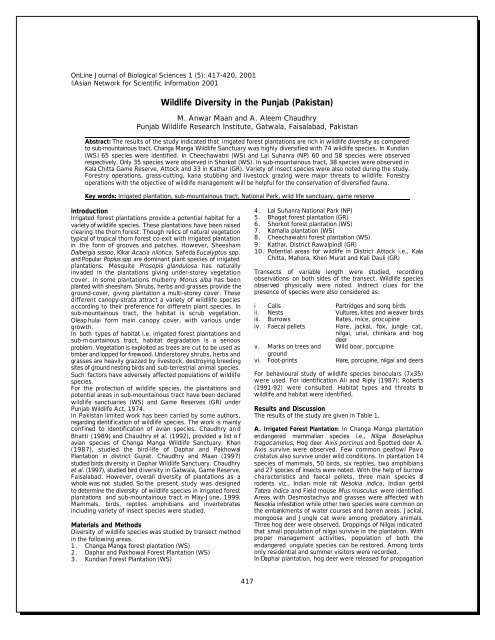

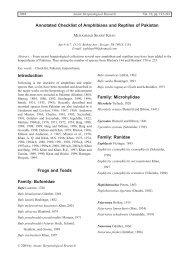

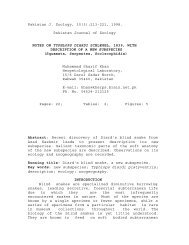


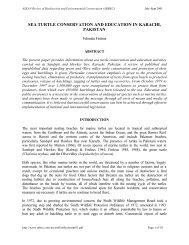
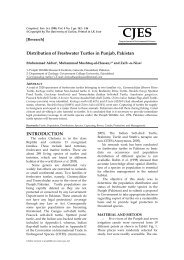
![Dureji (Ovis orientalis [vignei] blanfordi) - Wildlife of Pakistan](https://img.yumpu.com/11814520/1/190x245/dureji-ovis-orientalis-vignei-blanfordi-wildlife-of-pakistan.jpg?quality=85)
